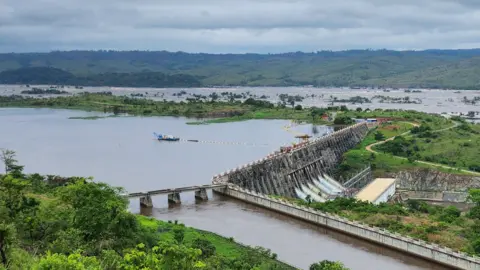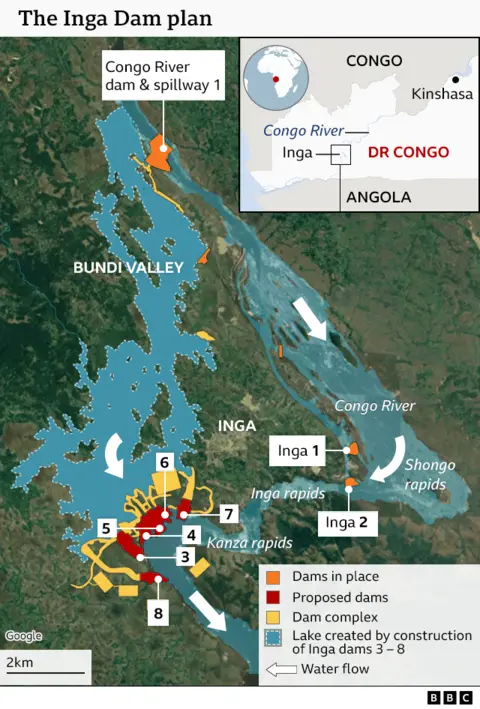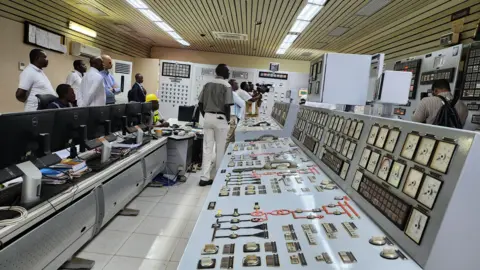BBC News
 Mbelechi Msochi
Mbelechi MsochiFrom a set of roaring rapids, comes a grand vision.
There are plans to build a magnificent, multi-billion dollar mega-dam on the Congo River – one that would produce enough renewable electricity to power vast areas of Africa.
The structure would be called the Grand Inga Dam. Located in the Democratic Republic of Congo, it would have twice the power generation of China’s Three Gorges and, therefore, be the world’s largest hydroelectric plant.
The Grand Inga Dam enticed investors and developers but decades after it was first dreamt up, the site reserved for the structure remains untouched.
While DR Congo’s government has insisted the plan is still in motion, critics point to the long delays, DR Congo’s record of poor governance and the potential for serious environmental harm.
There is also concern about the project’s revolving set of international partners. Just last week, Chinese state-owned firm the Three Gorges Corporation, withdrew from the project, a source close to the partnership told the BBC.
And then there is the eye-watering bill, which is reportedly as high as $80bn (£63bn) in a country that is one of the poorest in the world.
But some believe the nay-sayers are holding Grand Inga to a different standard than other major infrastructure projects. And while construction has not begun, there has been a flurry of meetings and discussions between interested parties over the past year.
The need for the Grand Inga is certainly there. Roughly 600 million people in sub-Saharan Africa lack access to electricity, according to the International Energy Agency, a global watchdog.
Attempts to solve this problem date back decades – and in the early 2000s DR Congo and its neighbours – South Africa, Angola, Namibia and Botswana – dreamt up an interconnected electricity grid.
They looked to the vast Congo River, realising that its powerful waters have an immense hydropower potential.
The international collective – known as Westcor – sought to multiply the two dams that already existed on the river – Inga 1 and Inga 2.
DR Congo’s long-time leader Mobutu Sese Seko oversaw their construction in the 1970s and 1980s, but by the end of the century, both dams were dilapidated due to a lack of funding for their maintenance.
Westcor eventually disbanded but their Grand Inga dream lived on. Inga 1 and 2 now work at around 80% of their capacity and DR Congo has drawn up plans to supercharge this output, by adding six more dams along the river.
These extra dams are forecast to generate up to 40,000MW of electricity at any one time – enough to power New York city for approximately four days during the summer.
Through Inga, DR Congo will play its role as “the trigger of the African revolver… a catalyst for the industrialisation of Africa,” says the country’s Agency for the Development and Promotion of the Grand Inga Project.
The BBC contacted the agency for this article but it did not comment.
Despite its previous projections that Inga 3 would be completed by 2018, construction has not even begun.
The lack of visible progress suggests the project has stalled, but recent messaging from the World Bank – the world’s leading development organisation – implies otherwise.

Late last year, the bank announced it was back in talks with the Congolese government, having withdrawn its funding for Inga 3 back in 2016.
The World Bank had cited “strategic differences” but eight years later – and with Félix Tshisekedi having replaced Joseph Kabila as DR Congo’s president – it has done a U-turn.
“I think it’s the first time that I feel more optimistic. I almost believe that we can get it done,” Demetrios Papathanasiou, the World Bank’s global director of energy and extractives, told a South African panel last February.
This optimism seemed to be felt elsewhere, also. A pan-African alliance of finance institutions – including the African Development Bank – has recently been working together to help attract private investment to the project.
The Grand Inga is like a “serpent – it is up, down, visible, not visible,” José Ángel González Tausz, chairman of AEE Power, a Spanish-run company and partner in the project, tells the BBC.
In November, Fabrice Lusinde, the head of DR Congo’s public electricity company Snel, said that if work on Inga 3 began in 2026, two of its turbines should be up and running by 2032. Electricity produced by these turbines would then finance the plant’s other turbines, he said.
On its own, Inga 3 is projected to produce 4,800MW of electricity. South Africa, a country hindered by regular power cuts, has signed a memorandum of understanding (MoU) stating that they will import just over half of this amount.
South Africa’s authorities have argued that Inga will deliver consistent and reliable energy, but critics in the country say cheaper electricity can be found elsewhere.
A Nigerian company, Natural Oilfield Services, has also reportedly signed up as a buyer. Like South Africa, Nigeria also suffers from severe electricity shortages.
Guinea and Angola have reportedly expressed interest in the Grand Inga Dam too.
So why – after decades of talks – have no new dams materialised?
“It is a project in the Democratic Republic of Congo,” Mr Tausz says bluntly. “Even if the project is one of the best all over the world – it does not have the credibility.”
For decades, DR Congo has been blighted by corruption, a lack of infrastructure and sluggish development. Conflict in the east of the country also makes international headlines – though Inga is thousands of kilometres away from the fighting.
Investors are also “afraid” because the Grand Inga would not show returns for decades, Mr Tausz says, adding “who knows what will happen in Congo in the next 30 years”.
Mr Tausz – whose father worked as an engineer on Inga 1 in 1972 – also says that a lack of financial commitment by the Congolese government has contributed to the delay.
And then there is the funding issue. In September 2023, DR Congo’s president told reporters that the country was “still facing difficulties in mobilising investments” for the dam.
The recent withdrawal of China’s Three Gorges Corporation intensifies these difficulties. Three Gorges was a major partner, which brought money and expertise to the complex project.
According to the BBC’s source, who spoke under condition of anonymity, Three Gorges pulled out as they were frustrated with the way DR Congo President Tshisekedi was handling the project.
There has been no official confirmation of the pull-out.
 Mbelechi Msochi
Mbelechi MsochiBut are these problems unique to the Grand Inga Dam? Not really, says Professor George Aggidis, a hydropower expert at the UK’s Lancaster University.
He says years of delays and numerous changes of partners are “normal” for a major infrastructure project like the Inga Dam.
He points to the UK’s Mersey Tidal Project – which if successful would be the world’s largest tidal barrier. The idea was first floated in 1984 and has been abandoned, then revived in the decades since.
“Does that mean we are unstable here in the UK?” Mr Aggidis asks. He describes the Inga project as “doable”.
A similar sentiment is shared by Alexander Schwab, an executive at Andritz, an Austrian-based company that signed on to supply equipment for Inga 3.
Mr Schwab says Andritz signed a MoU with the Congolese authorities but has not received any word on the project since 2021.
He seems largely unfazed by the lack of communication, saying that one in three major infrastructure projects will be “stalled somewhere”.
For Mr Schwab, the Grand Inga is “one of the best mega projects… in the world”.
But despite its potential, there are deep concerns about the project’s environmental and social impact.
A common criticism is that the dam will benefit South African consumers and DR Congo’s mining companies, but not the Congolese people. Some 80% of the population lack access to electricity.
“Inga will not bring electricity for the people,” says Emmanuel Musuyu, the head of Congolese civil society coalition Corap. He alleges that the majority of electricity has already been promised to South Africa and the mines.
In a recent report on Inga 3, the DR Congo authorities acknowledged that the dam is “alone not sufficient to address DRC’s energy and development challenges” but said it could act as a “catalyst” for national change.
The World Bank said it was exploring how it could support the government to ensure Inga “delivers broad benefits for energy access”.
Environmental and rights groups also worry that approximately 37,000 residents in the Inga area will be displaced without compensation. According to organisations like International Rivers and Observatori del Deute en la Globalització, thousands were forcibly removed from their homes and never compensated when Inga I and II were built.
They also say that the first two dams damaged the region’s biodiversity and that any extra dams are likely to do the same.
“It will have a specific impact on the fish and all animals in the water… when you change the flow of water in rivers, we can see some species of fish disappear,” says Mr Musuyu.
A 2018 study argued that many large-scale hydropower projects in Europe and the US have been disastrous for the environment.
DR Congo’s authorities have recognised that people would be displaced by Inga III, but said residents would be resettled in areas with basic services and promised that “fair compensation” would be awarded.
They have also recognised the risks to the local environment and said an assessment aiming to reduce this impact would be completed within the next two years. However, according to the BBC’s source close to the project, the authorities have not yet raised enough money to fund these studies.
If the Grand Inga is simply experiencing the ups and downs that come with big infrastructure projects, the World Bank may still have cause for optimism.
But the dam is a complex engineering project – one that requires its many stakeholders to work together in harmony.
The World Bank returning, only for the Three Gorges to leave, suggests DR Congo is struggling to maintain such unity.
And despite DR Congo’s ambition, construction cannot begin unless funding is secured.
So for now, it appears as though this project which has the potential to change the lives of millions of people in Africa remains just that – a grand vision.
You may be interested in:
 Getty Images/BBC
Getty Images/BBC